Kuna Yala (aka San Blas islands) November 9 to December 9, 2012
Kuna Yala is a semi-autonomous region of Panama. The region is an archipelago of islands (300 – 400 of them) and a long thin strip of Atlantic-side mainland adjacent to the islands. Kuna Yala begins just west of the border with Colombia.
The region is mostly governed and peopled by the Kuna indians, many of whom live in family or tribal communities. Homes are typically made of bamboo with thatched roofs. The men mostly fish, gather coconuts, and do some subsistence farming on the mainland (bananas, plantains, yucca, mango, etc.). Kuna society is matriarchal. The women make molas for sale to collectors and tourists and so are major contributors to the economy of Kuna Yala. The women also wear traditional dress.
Kunas own all the coconuts in Kuna Yala. Every island (inhabited or not) has been planted with coconuts. Coconuts are bought by Colombian traders who visit the islands in small freighters.
Kunas travel all over Kuna Yala harvesting coconuts. This man is sailing his coconut-filled ulu (dugout canoe) over 2 miles from Aridup to Playon Chico.
The day we were in Playon Chico, the Kuna were trading plantains for detergent, salt, crackers, and children’s clothing from Colombia.
The Kuna earn some money by taxing yachts. Each area in Kuna Yala levies its own taxes. We were taxed four times in the course of our month. In each case, it was an older man alone in a ulu who came to collect the tax. The taxes were ~$10 and good for an extended time period. A receipt, printed or stamped with the name of the community, was exchanged for the tax money. Keep the receipt as proof of payment so that you can’t be taxed twice.
At Niadup, our tax collector, Señor Aquilino offered to give us a tour of the village the following day. We took him up on the offer.
The Kuna villages we saw were all densely populated:
On our tour of Niadup, we saw all three churches: the Catholic church, the Baptist church, and the Mormon chuch. The Catholic church is the oldest.
We also saw the Congresso house where most nights a week everyone gathers to discuss village matters. In traditional villages, this is quite formal with the chief in his hammock in the centre along with his interpreter and everyone else sitting on benches around the edge of the room. And when the proceedings are dull, someone shouts loudly at random intervals to wake up the dozers. (I read this in the guide book — didn’t witness it myself.)
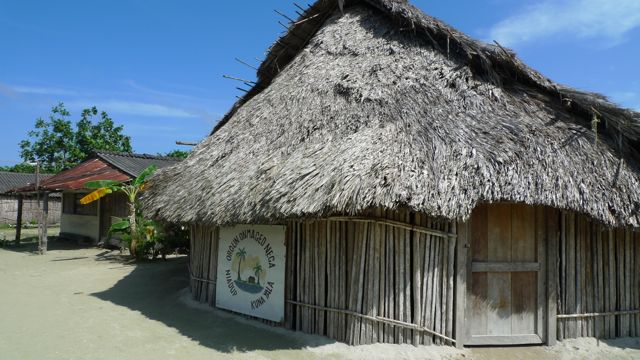
The congresso house at Niadup. Our guide explains that the meeting starts between 6 pm and 7 pm and goes until 9 pm or 10 pm every night.
We were in Niadup at the start of school vacation. The place was overrun with children playing outside.
However, not every kid should play outside. Due to inbreeding, there are a lot of albino Kunas. During our month stay, we saw six. Our guide explained that the little guy in the photo below had got such a sunburn on his hand that it was wrapped up to heal. He asked us if we had any creams on our boat to help. We donated three high-SPF sunscreens and and bottle of soothing aloe.

Albino Kuna child in Niadup. (Aside: adults didn’t want their pictures taken. When we got out our camera, they plunked the child on the chair and then ran out of the frame.)
Also in Niadup, we met a local painter and bought one of his attractive paintings depicting life in Kuna Yala in days gone by.
Tony was supposed to be taking the kids alone (photo below) but caught the un-posed shot above too.

Before this official picture was taken, the mom ran a comb through the boys’ hair — such a universal mother action.
And to conclude, a final snap with our guide.
Postscript to answer Pat’s question:
One of the islands (Isla Tigre) keeps pigs. They keep the pigs in clever “self-cleaning” pens by the sea. When the tide is high, the pens get cleaned out.

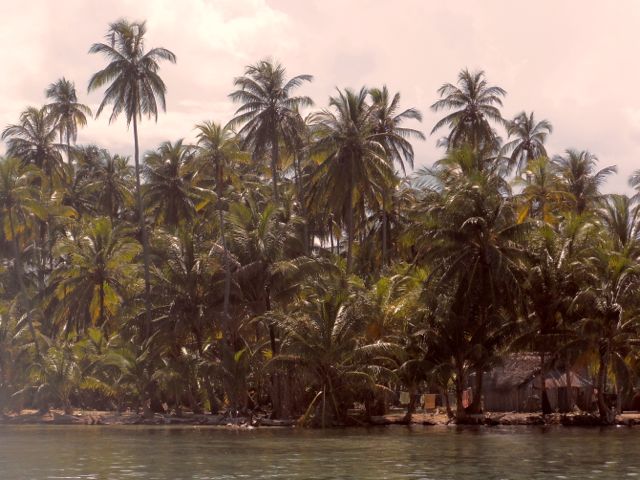
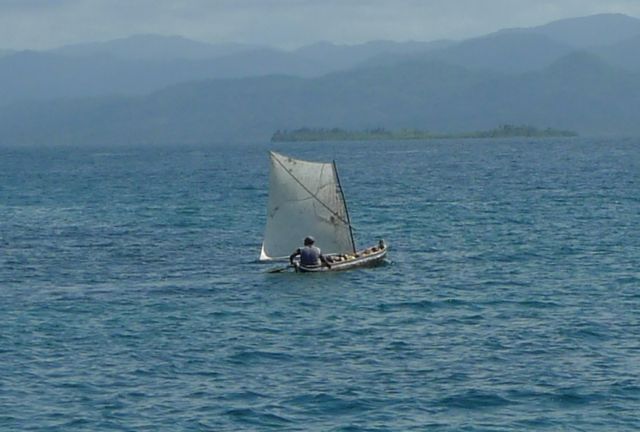
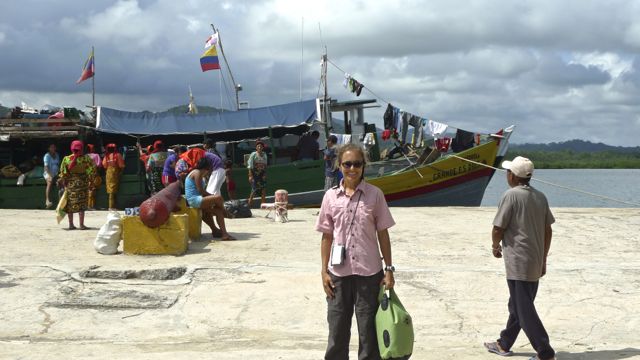


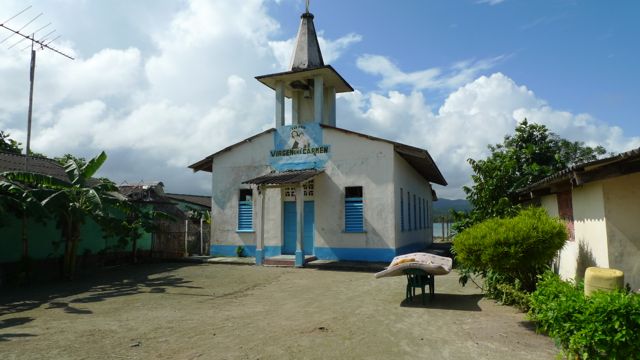
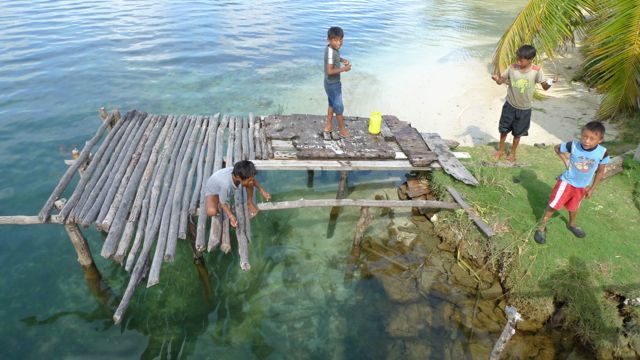
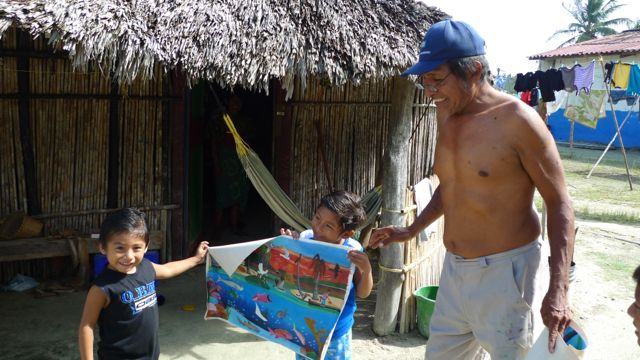
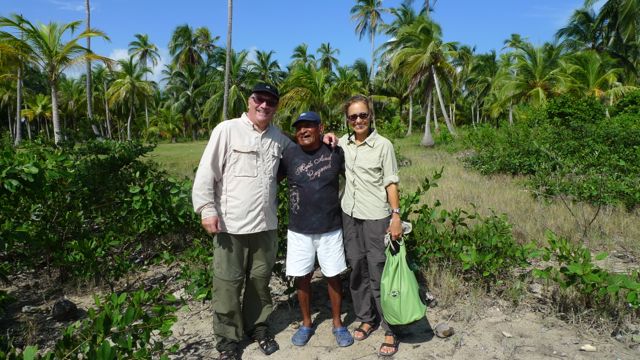
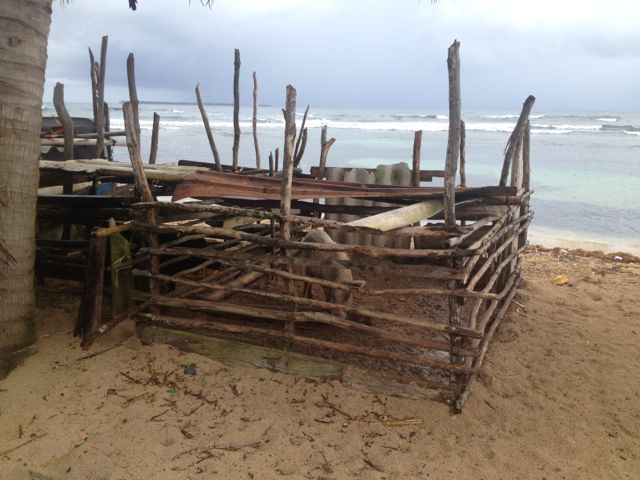
Very interesting.. Do Kunas eat any meat, and if so, what kind? What kind of animals exist on the islands? Have you seen any weapons on the islands?
Re: meat and animals: The only fresh meat we saw in the shops was chicken — not refrigerated but kept in buckets of water. I heard that for feasts, they hunt deer on the mainland. I don’t remember seeing any wild animals on the islands. Though, dogs and cats are popular as pets.
Re: weapons: There is a border guard police station at Playon Chico; both the guards were armed. Also, I saw two guards/soldiers in front of the bank in Nargana. That was it for weapons.
Gorgeous! I live vicariously through ya’ll and update my desktop with your beautiful photos!
Wonderful post.
So glad that you and Tony were able to enjoy further exploration of the Kuna Yala! Thanks for sharing Jane!